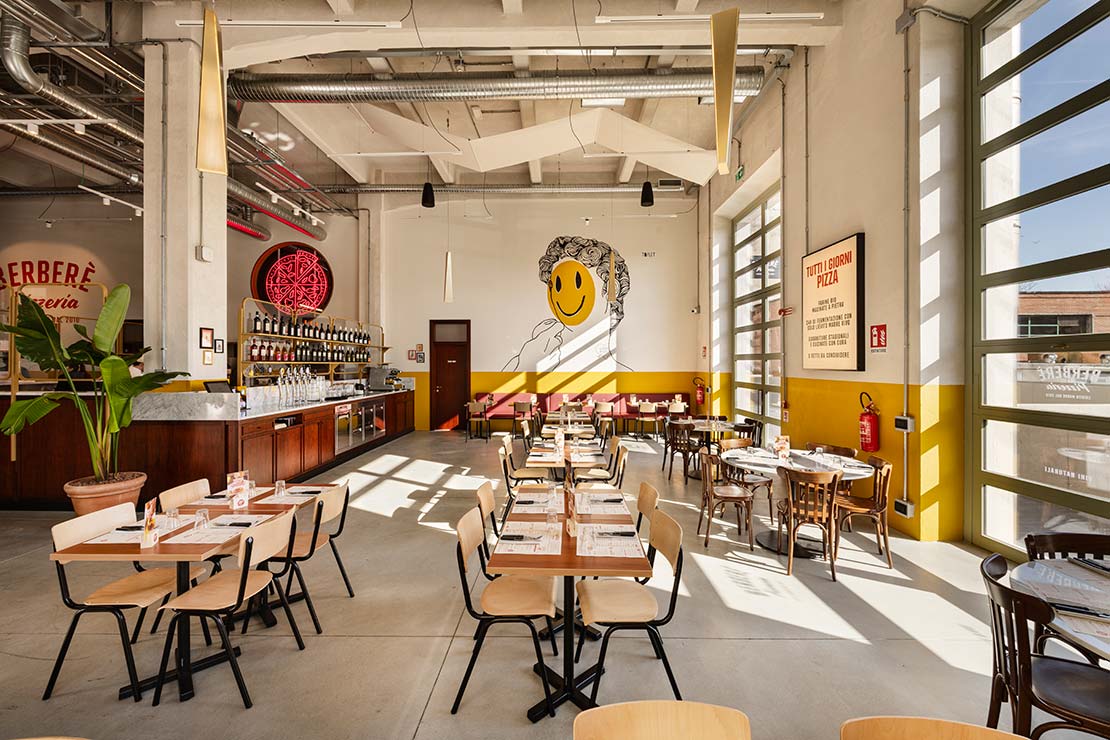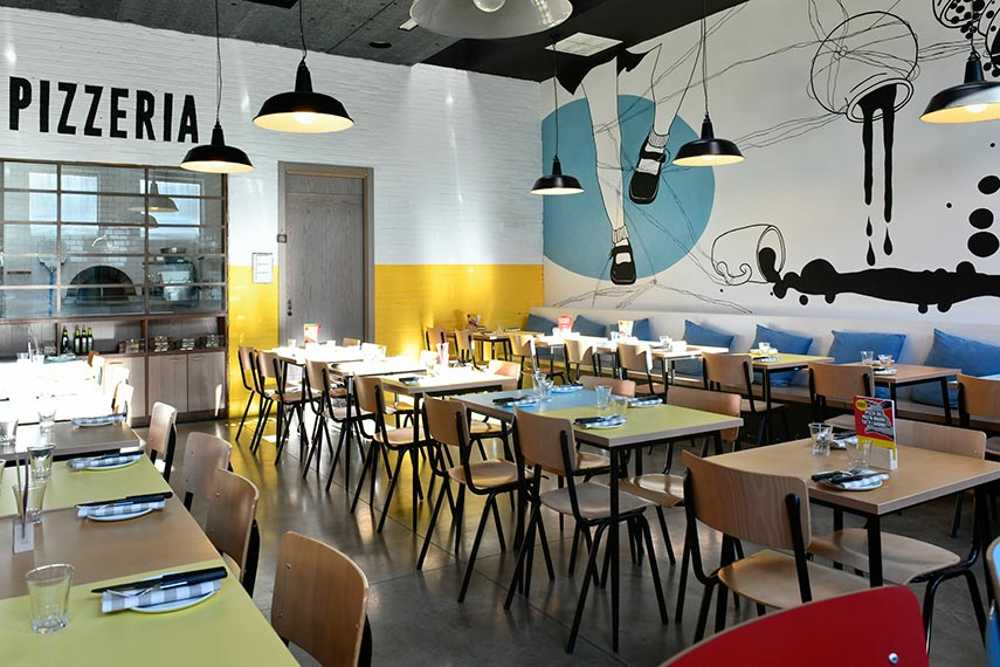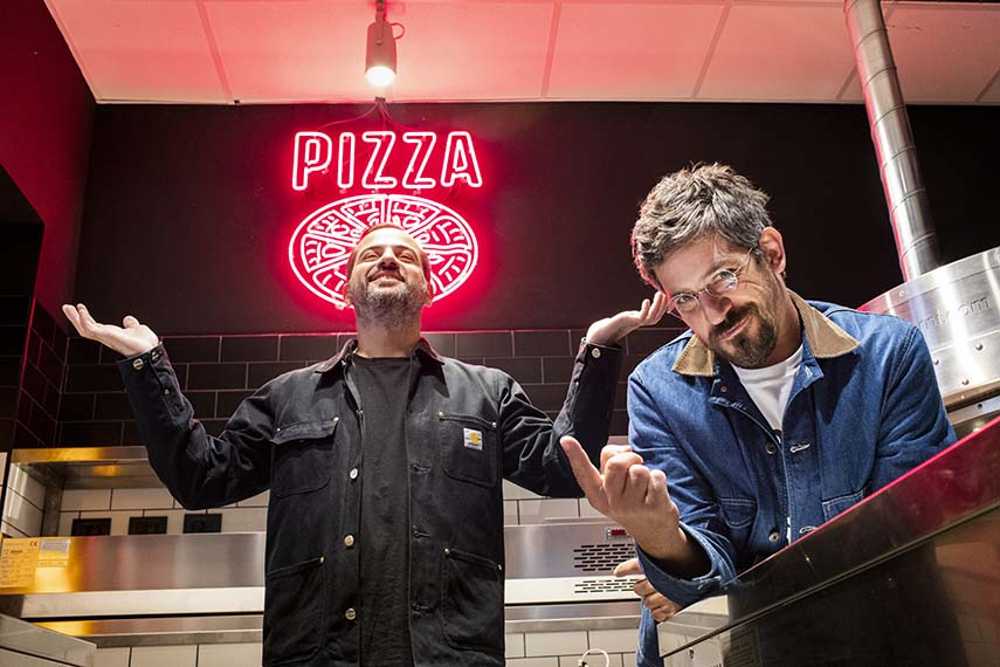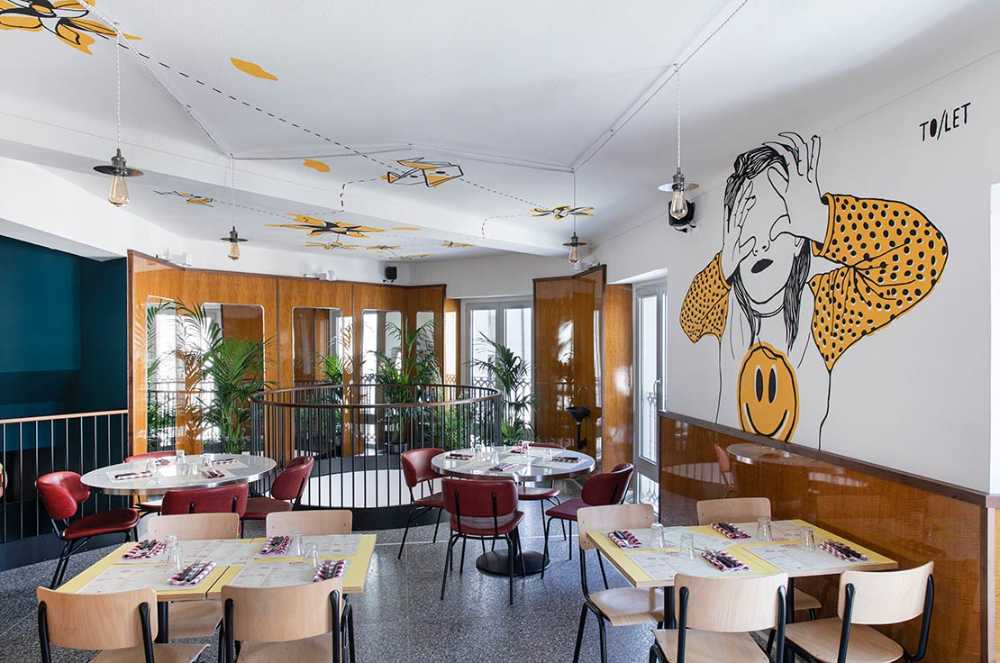The Berberè pizzerias combine culinary excellence and captivating design. Carefully designed and respecting the history of each space, they welcome and engage the customer in a sensory experience that involves not only taste. Each location stands out for its aesthetics and unique setups, but united by common elements: colorful environments, open kitchens, distinctive wall paintings, and pop details that convey the brand's philosophy.


Genuine taste and refined design, the combination that distinguishes Berberè
Today, in defining the culinary experience, different factors contribute, among these certainly also the environment, almost as much as the menu proposal. Berberè represents an emblematic example of modern gastronomic trends, which enhance every aspect of the offer to the customer.

Berberè was born in 2010 from the idea of two young entrepreneurs, the brothers Matteo and Salvatore Aloe. The first pizzeria was opened in Castel Maggiore, and today there are 18 pizzerias scattered throughout Italy, and 2 beyond national borders, in London. It ranks 5th in the 2023 ranking for the best artisanal pizza chains in the world compiled by 50 Top Pizza. It has recently received confirmation of the prestigious recognition: 3 Spicchi Award assigned by Gambero Rosso to the Castel Maggiore location, within the 2024 Pizzerias Guide. The essence of Berberè lies in its dedication to craftsmanship. The name, which evokes a mix of spices originating from the Horn of Africa, symbolizes the uniqueness and fusion of different skills in creating its pizzas.

I asked Matteo and Salvatore to tell us how Berberè venues are born and what ideas underlie the aesthetic taste and architectural design.
#1 answers
Hello Salvatore, hello Matteo, as a frequent visitor of your venues in Bologna, I can confirm everything you say: "Delicious pizzas in beautiful places." The distinctive aesthetics of Berberè clearly convey a strong conceptual vision. What were the main influences and stylistic mood that you decided to incorporate into the design of your pizzerias?
First of all, thank you very much for being a Berberè visitor, also on behalf of the staff, the kind people who take care of our customers.
Since 2010, the year we opened our first pizzeria, we have tried to introduce the contemporary ingredient even in the design, not just in the pizza product. On the other hand, in a pizzeria, people go to spend time, so the experience is made up of many things, not just food but also service, music, comfort, and, indeed, design. We studied in Bologna, so probably the greatest influence came from street art and the colors of the city. Furthermore, we love to travel and observe what happens abroad, so there are international influences, especially we think of London and New York.
One of the essential stylistic elements is the wall painting, always different for each venue, which is not directly related to the brand, but is an expression of craftsmanship, art, and creativity. These are not replicated works, but always site-specific.
#2 answers
Berberè is present in various Italian cities, including London, considering that each location for your pizzerias has a unique and distinctive character, how do you choose the architectural spaces, i.e., what specific criteria guide the selection of spaces?
There are some minimal commercial characteristics, traffic, resident population, costs, etc. We always look for places with inherent character, perhaps unexpressed, places that have a history: from the former FIAT factory in Turin Binaria, to the former Social Circle Sassetti in Milan Isola or a street in the university heart of Bologna such as via Petroni.
For example, in the Milan Isola venue, we kept the original mosaic floors. We like elements that tell the story of places: from a gantry crane of the former factory, to exposed bricks and arches of the former warehouses in Milan Navigli.

The latest addition to the Berberè family is the pizzeria at Manifattura Tabacchi in Florence, and Giambattista Ghersi from Avamposti, the architecture studio that oversaw the project, spoke to us about their work on this space.
#3 answers
The most recent project you worked on for Berberè is the newly opened location at Manifattura Tabacchi in Florence, a famous former cigar factory active for over seventy years and decommissioned starting from 2001. A historic place now at the center of an important urban regeneration initiative. How did you integrate Berberè's design needs with the respect and enhancement of the site's architectural identity?
The project of the Berberè location within the urban redevelopment of Manifattura Tabacchi, blends the preservation of Pier Luigi Nervi's original structural system with a tribute to Renaissance Florence. Structural and decorative elements recall the Church of San Lorenzo, such as the cement columns that evoke Renaissance capitals and the pizza-shaped neon light reminiscent of a rose window. Special attention was given to the visibility of Nervi's structure, with the addition of a dividing wall between the dining area and the kitchen. The interiors are designed to emphasize conviviality, with carefully crafted lighting and architectural details that visually expand the space. The venue includes a central open kitchen, surrounded by a cherry wood and Carrara marble bar, seamlessly integrating the industrial context with a touch of Renaissance elegance.
A special mention goes to the lighting, as Berberè Manifattura Tabacchi inspired the creation of 9 lighting fixtures, designed for the occasion by Avamposti Architettura and produced in the special style of the Viabizzuno® brand. The creative process of this site-specific furnishing object draws from forms already seen in Nervi's structures, in an imaginary design dialogue that further enhances the abundant light flooding the room with precious plays of light refraction.

In every Berberè location, there are no shortage of designs and paintings by the visual artists TO/LET that characterize and animate the walls. Sonia and Elisa talk about their collaboration with Berberè.
#4 answers
Hello Sonia, hello Elisa, you have described your works as site-specific and stated that you collaborate with supported entities: social centers, festivals, and private commissions only if the project aligns with your beliefs. How did the long-standing collaboration with Berberè come about? And why did you choose large wall paintings among the various expressive means you use for this project?
The collaboration between us and Berberè began in 2010 when we painted the first location in Castel Maggiore. It was our first private commission for a commercial venue, after completing the Academy of Fine Arts and following an artistic path that led us to independent and non-independent festivals, social centers, and art galleries.
It was Comunicattive, a communication agency that still oversees Berberè's projects, that introduced us to Salvatore and Matteo. When Samantha Cavicchi first introduced us to Salvatore and Matteo, we immediately felt they were wonderful people, a fundamental requirement for deciding whether to work on a commission. We admired their courage and determination to embark on that new and important adventure.
Since the first Berberè in Castel Maggiore, always having had maximum freedom of expression, we chose drawing and painting as our expressive media because we believe these are the means that best represent us and allow us the greatest freedom of intervention within the venues. Over time, encouraged each time to raise the bar, both by Samantha and by Salvatore and Matteo, we have not limited ourselves to painting only on defined walls, but we have created 360-degree rooms, our designs have climbed onto ceilings, descended onto mirrors, and risen on walls, stairs, in a site-specific mood that we believe sets us apart.
Gallery
Credits
Cover image: Bruno Gallizzi
Text images: Bruno Gallizzi
Gallery images: N.1 Bruno Gallizzi, from N.2 to N.5 Federica Dattilo, from N.6 to N.9 Bruno Gallizzi, N.10 Angela Ricò, N.11 Bruno Gallizzi, N.12 Bruno Gallizzi, and finally N.16 and N.17 Federica Dattilo, and from N.18 to N.20 Bruno Gallizzi
Drawings: N.13, N.14, N.15 Avamposti Architettura





















